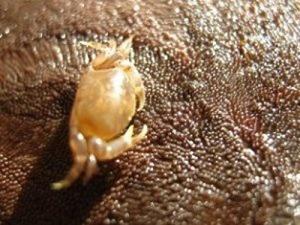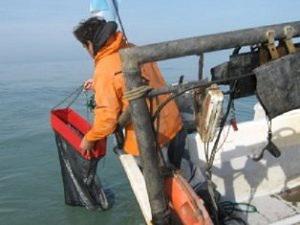Maria Florencia Spina
The main purpose of this work is to analyse the impact of bottom trawling activities on part of the Buenos Aires coastal ecosystem. Then, use the information gathered to support the validity of the regulation that protects the area against trawl fishing.

Crab walking on a sea dollar E. emarginata.
The benthos constitutes a source of food for demersal and bottom fish; therefore, its conservation is of critical importance for the preservation of marine ecosystems. If the sea bottom is altered by trawling, the benthic community may also be affected. This might trigger off a series of chain reactions involving the ecosystem.

Fisherman starting sampling with the dredge.
In Argentina, along the coasts of Buenos Aires Province, there is a bottom trawl fishing fleet. The fishing activities performed by this fleet might involve potential alterations to the benthic community, which could affect species classified as vulnerable or endangered.
Pursuant to Resolution No. 18/06 adopted by the Undersecretariat for Fisheries of the Ministry of Agricultural Affairs of Buenos Aires Province, all artisanal vessels using passive fishing gears shall have exclusive access to the first 5 nautical miles of the maritime zone, the use of trawl nets being absolutely banned within said area. Even though said resolution is currently in force, it is questioned year on year due to the economic interests prevailing in the area, which are related to the trawl fishery for coastal commercial species.
At present, there are no available studies on the impact of the trawl fishery on the benthic ecosystem to support the uninterrupted enforcement of this regulation. This work would be a first approach to the problem, since it would analyse the impacts of trawling activities on the ecosystem by comparing the benthos community in areas subjected to bottom trawling and protected areas.
Over a one-year period, samples shall be collected from the seafloor by using a dredge in sampling stations located in areas ecologically similar. Samples collected, fixed and kept in labelled bottles shall be analysed, determining the individuals to the lowest possible level, including its weight and length. Based on the length of the dredged area and the width of the dredge to establish the corresponding surface, the abundance and biomass of the populations shall be estimated for each surveyed area. The data analysis about the benthic communities shall be used to assess the effects of fishing on a community and the level of disturbance.
Fishermen consider that Resolution No. 18/06 is important because it protects their nets from being dragged by vessels; however, they fail to understand the ecosystem preservation underlying issue and how it affects their own fishing activities. The foregoing shall be addressed with the artisanal community by conducting an activity–workshop.